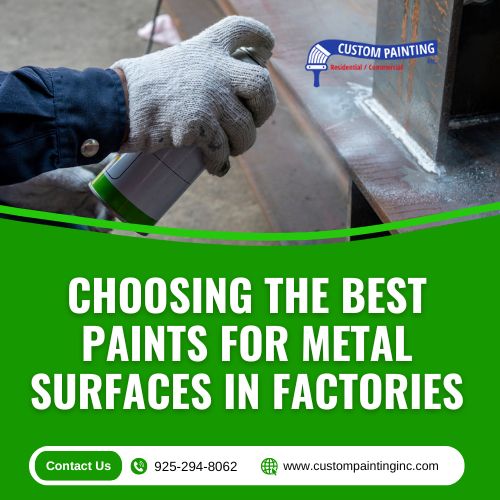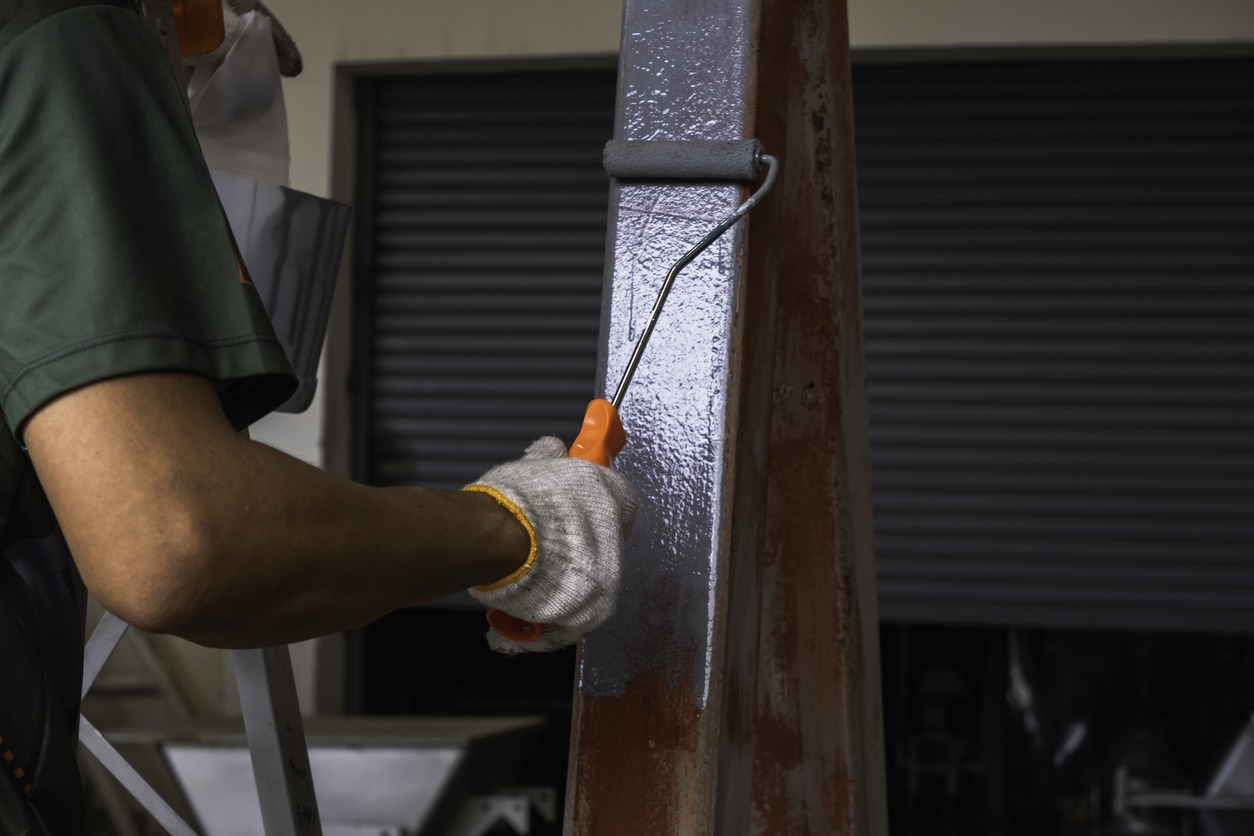Protecting the metal surfaces in factories is essential to prevent rust, wear, and damage from harsh environmental conditions. The right paint not only enhances the durability of metal but also contributes to workplace safety by reducing corrosion-related hazards. Plus, a fresh coat of paint can significantly improve the appearance of industrial spaces, adding a polished, professional look.
Partnering with a commercial painting company can make all the difference—they have the expertise to recommend the best coatings and ensure that factory metal surfaces are protected with high-quality, long-lasting finishes.
Challenges of painting metal surfaces in industrial environments
Painting metal surfaces in industrial environments presents several challenges:
- Exposure to harsh conditions: Metal surfaces in factories often face moisture, chemical exposure, extreme temperatures, and heavy use. These conditions can quickly wear down paint and lead to frequent maintenance, increasing downtime and costs.
- Preventing rust and corrosion: Humidity and chemical exposure make industrial settings prone to rust, which deteriorates metal surfaces. Selecting paints with anti-corrosive properties is crucial to protect against rust, prolonging the lifespan of the paint and the metal underneath.
- Adhesion and durability: Ensuring that paint adheres well to metal is challenging, especially under heavy use and exposure to fluctuating conditions. Specialized primers and durable, industrial-grade paints are essential for a strong bond that withstands daily wear, reducing the need for frequent repainting and minimizing disruptions to operations.
Types of paints suitable for metal surfaces
- Epoxy paints: Epoxy coatings are highly durable, providing strong adhesion and excellent resistance to chemicals, solvents, and abrasions. These attributes make epoxy paints ideal for metal surfaces in high-traffic areas or industrial settings where the metal may be exposed to harsh substances. Epoxy forms a thick, protective layer that withstands wear and tear, preserving the metal’s integrity.
- Polyurethane paints: Polyurethane paints are known for flexibility and resilience. They are well-suited for metal surfaces that face temperature fluctuations or physical impacts. This paint type maintains its appearance and protection even under challenging conditions, such as outdoor environments or areas subject to frequent handling and impact.
- Acrylic paints: Acrylic paints offer strong UV resistance, making them a good choice for outdoor metal surfaces exposed to sunlight. They resist fading and maintain color vibrancy over time, which is ideal for exterior metal furniture, railings, or outdoor structures. Acrylics also dry relatively quickly, simplifying the painting process.
- Zinc-rich primers: Zinc-rich primers are essential in protecting metal from rust and corrosion. They contain a high concentration of zinc particles, which act as a sacrificial layer to prevent the metal from oxidation. These primers create a robust base for topcoats and are especially effective in harsh environments, such as coastal or industrial areas.
Factors to consider when choosing paints for metal surfaces
- Environmental conditions: The paint should be selected based on exposure to temperature, humidity, and chemicals. High temperatures or constant moisture can cause ordinary paints to fail, so heat-resistant or rust-preventive coatings are ideal. Select a paint with chemical resistance for metal surfaces exposed to chemicals or abrasives to ensure a lasting finish.
- Required durability: Areas within a factory, such as machinery, walkways, or storage tanks, require different levels of durability. Machinery needs a tough, abrasion-resistant coating to handle impact and wear, while walkways often need non-slip and durable finishes due to heavy foot traffic. Storage tanks may need corrosion-resistant paint to withstand weather exposure.
- Aesthetic and branding needs: Color selection is crucial for maintaining a cohesive brand look and creating a professional atmosphere. Using company colors on visible metal structures can strengthen brand identity, while a clean and well-maintained appearance promotes a positive image.
Preparing metal surfaces for painting
Preparing metal surfaces for painting is crucial for a long-lasting and durable finish.
- Surface cleaning and degreasing: To ensure the paint adheres properly, thoroughly clean the surface to remove grease, oil, and dirt. You can use a degreaser or detergent solution and follow it by a rinse and drying. Even slight residues can prevent paint from sticking, leading to early peeling or bubbling.
- Rust and old paint removal: Remove rust and loose old paint to create a smooth, clean surface. Abrasive blasting (such as sandblasting) is effective for heavy rust. Sanding or wire brushing, on the other hand, can work on smaller areas. Removing all traces of rust ensures new corrosion won’t form under the paint.
- Priming for longevity: Apply a quality metal primer. This step is essential, especially in high-humidity or high-wear areas. Primers enhance paint adhesion and provide additional protection against rust and corrosion, extending the life of the paint and the metal surface itself.
Application techniques for optimal results
- Spray vs. brush and roll techniques: Spray application offers an even, thin coat ideal for large metal surfaces and intricate areas like railings or decorative details. It provides a smooth, professional finish without brush marks. Spraying also speeds up application in expansive areas. Brushing or rolling, however, is more practical for smaller areas or touch-ups where more control is needed, and it avoids overspray in confined spaces.
- Multi-coat systems: Using a primer, intermediate coats, and a topcoat creates a durable, multi-layered barrier against rust and corrosion, enhancing the paint’s adhesion and durability. Primers prepare the surface by filling minor imperfections and promoting topcoat adherence, while intermediate layers add extra protection. A high-quality topcoat provides a final layer of weathering, UV, and wear resistance.
- Drying and curing times: Sufficient drying and curing times between coats are crucial for a durable, chip-resistant finish. Drying ensures each layer sets correctly. Curing, on the other hand, creates a solid bond to the metal. Rushing this process can lead to peeling or chipping, reducing the paint job’s longevity, so following the manufacturer’s recommended times is crucial to achieving optimal results.
Long-term maintenance and repainting tips
- Routine inspections: Regularly check metal surfaces for signs of wear, rust, or peeling paint, particularly in high-exposure areas or climates with high humidity. Early detection allows quick repairs, preventing serious issues and prolonging the finish.
- Cleaning and minor touch-ups: To clean painted metal surfaces, use a soft cloth and mild soap with water. This step removes dirt, grime, and corrosive substances, helping preserve the paint. Avoid harsh chemicals and abrasive cleaners, which can damage the finish. For minor touch-ups, apply matching paint to any chips or scratches to prevent rust from spreading.
- Knowing when to recoat: If you notice fading, cracking, or peeling paint, it’s likely time for a new coat. These signs suggest the paint is no longer effectively protecting the metal and should be recoated to maintain appearance and durability.
Parting words
Choosing the appropriate paints and preparation techniques for metal surfaces in factory environments is essential to ensure long-lasting protection, durability, and aesthetic appeal. Proper surface preparation with high-quality, industrial-grade paints can significantly enhance the lifespan and appearance of metal fixtures in demanding conditions.
Consulting with a commercial painting company provides valuable expertise and ensures that these surfaces are treated with the most suitable products and techniques. For optimal results and tailored industrial painting solutions, contact Custom Painting, Inc.’s experts! Call us at 925-294-8062 or message us here for a free quote.



